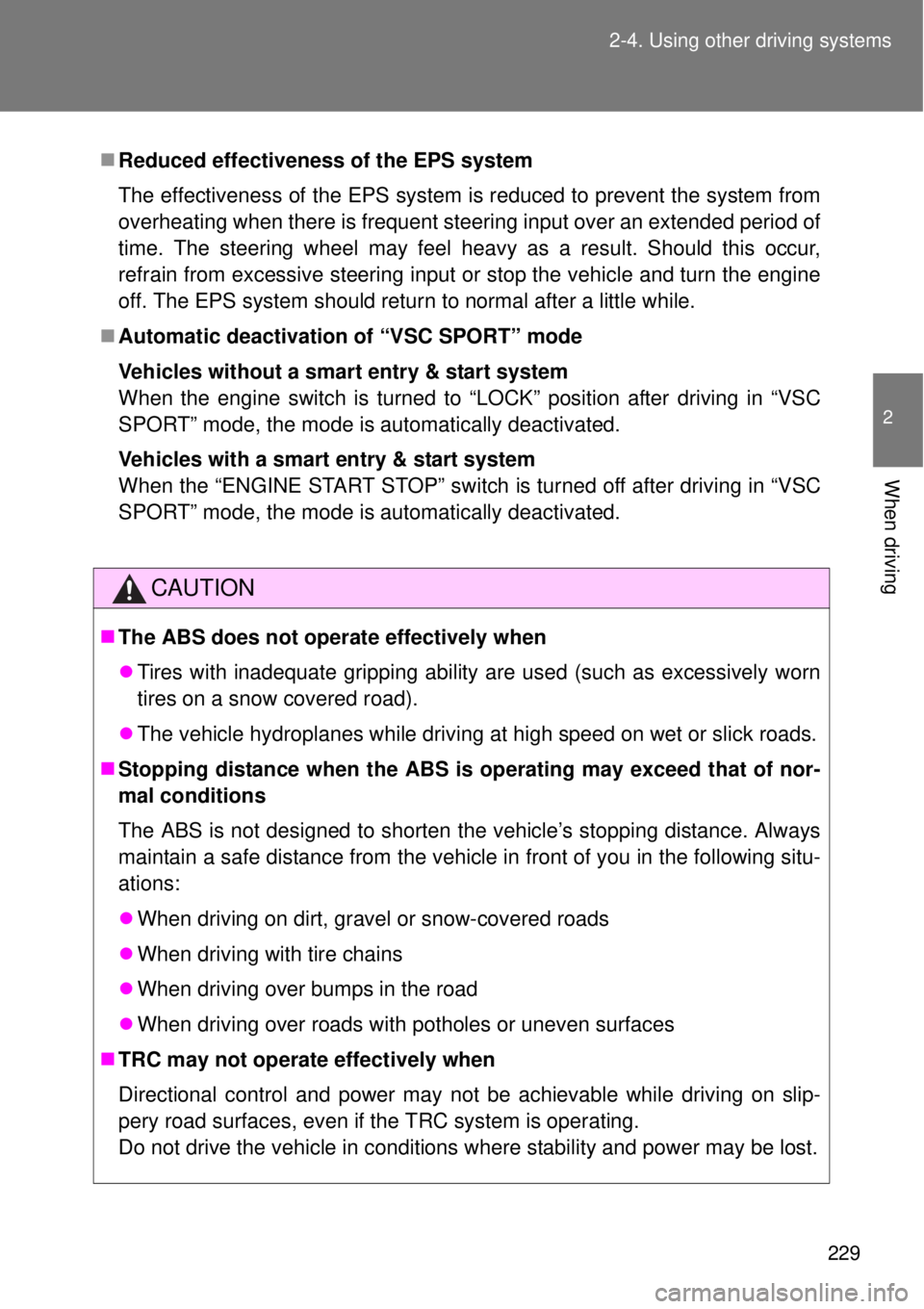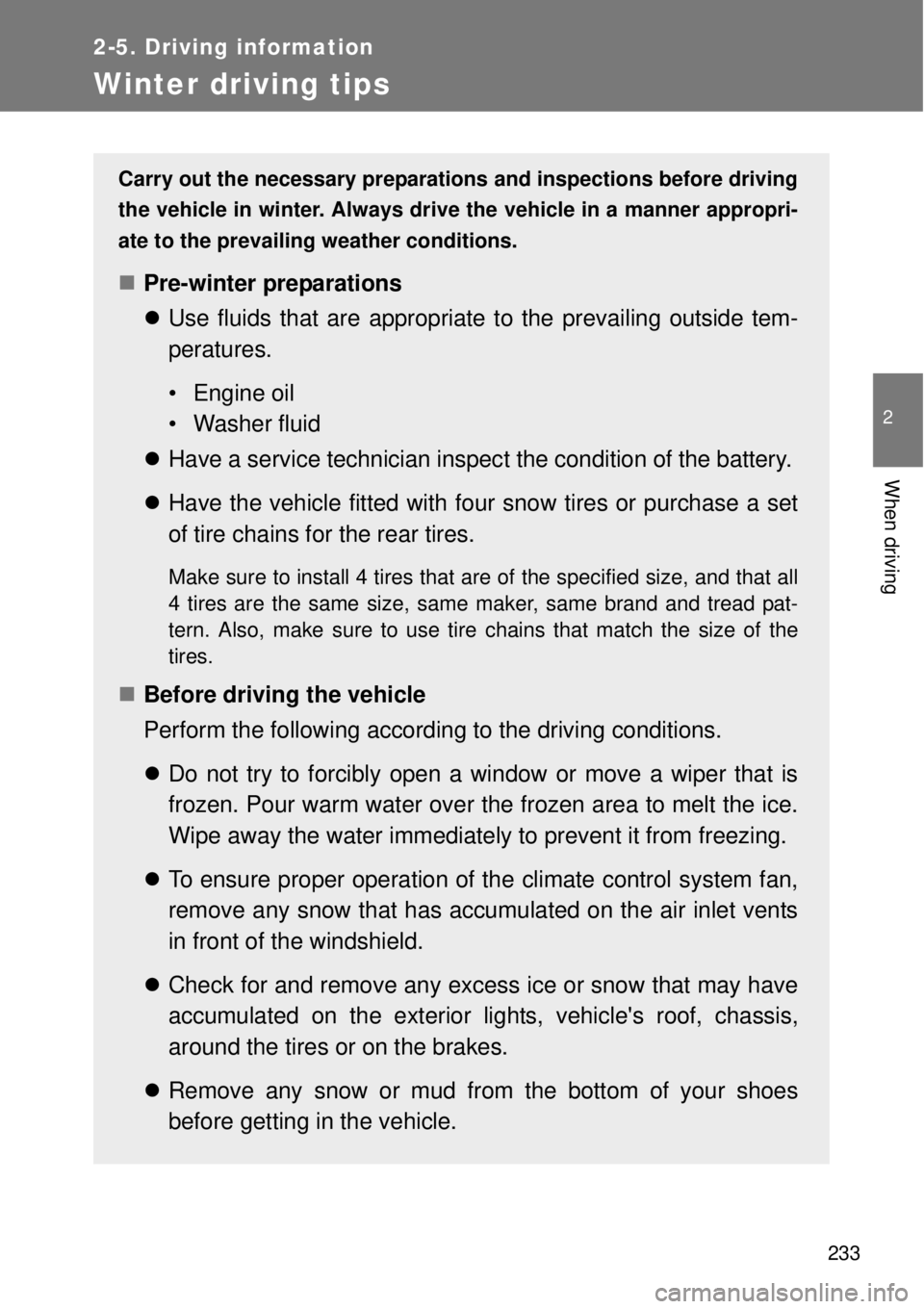2014 TOYOTA GT86 snow chains
[x] Cancel search: snow chainsPage 229 of 464

229 2-4. Using other driving systems
2
When driving
Reduced effectiveness of the EPS system
The effectiveness of the EPS system is reduced to prevent the system from
overheating when there is frequent steering input over an extended period of
time. The steering wheel may feel heavy as a result. Should this occur,
refrain from excessive steering input or stop the vehicle and turn the engine
off. The EPS system should return to normal after a little while.
Automatic deactivation of “VSC SPORT” mode
Vehicles without a smart entry & start system
When the engine switch is turned to “LOCK” position after driving in “VSC
SPORT” mode, the mode is automatically deactivated.
Vehicles with a smart entry & start system
When the “ENGINE START STOP” switch is turned off after driving in “VSC
SPORT” mode, the mode is automatically deactivated.
CAUTION
The ABS does not operate effectively when
Tires with inadequate gripping ability are used (such as excessively worn
tires on a snow covered road).
The vehicle hydroplanes while driving at high speed on wet or slick roads.
Stopping distance when the ABS is operating may exceed that of nor-
mal conditions
The ABS is not designed to shorten the vehicle’s stopping distance. Always
maintain a safe distance from the vehicle in front of you in the following situ-
ations:
When driving on dirt, gravel or snow-covered roads
When driving with tire chains
When driving over bumps in the road
When driving over roads with potholes or uneven surfaces
TRC may not operate effectively when
Directional control and power may not be achievable while driving on slip-
pery road surfaces, even if the TRC system is operating.
Do not drive the vehicle in conditions where stability and power may be lost.
Page 233 of 464

233
2-5. Driving information
2
When driving
Winter driving tips
Carry out the necessary preparations and inspections before driving
the vehicle in winter. Always drive the vehicle in a manner appropri-
ate to the prevailing weather conditions.
Pre-winter preparations
Use fluids that are appropriate to the prevailing outside tem-
peratures.
• Engine oil
• Washer fluid
Have a service technician inspect the condition of the battery.
Have the vehicle fitted with four snow tires or purchase a set
of tire chains for the rear tires.
Make sure to install 4 tires that are of the specified size, and that all
4 tires are the same size, same maker, same brand and tread pat-
tern. Also, make sure to use tire chains that match the size of the
tires.
Before driving the vehicle
Perform the following according to the driving conditions.
Do not try to forcibly open a window or move a wiper that is
frozen. Pour warm water over the frozen area to melt the ice.
Wipe away the water immediately to prevent it from freezing.
To ensure proper operation of the climate control system fan,
remove any snow that has accumulated on the air inlet vents
in front of the windshield.
Check for and remove any excess ice or snow that may have
accumulated on the exterior lights, vehicle's roof, chassis,
around the tires or on the brakes.
Remove any snow or mud from the bottom of your shoes
before getting in the vehicle.
Page 235 of 464

235 2-5. Driving information
2
When driving
Selecting tire chains
We recommend that you consult any authorized Toyota dealer or
repairer, or another duly qualified and equipped professional for infor-
mation about the chains that you can use.
Regulations on the use of tire chains
Regulations regarding the use of tire chains vary according to loca-
tion and type of road. Always check local regulations before installing
chains.
Tire chains
Observe the following precautions when installing and removing chains.
Install and remove tire chains in a safe location.
Install tire chains on the rear tires. Do not install tire chains on front tires.
Install tire chains on rear tires as tightly as possible. Retighten chains
after driving approximately 100 m (328 ft.).
Install tire chains following the instructions provided with the tire chains.
CAUTION
Driving with snow tires
Observe the following precautions to reduce the risk of accidents.
Failure to do so may result in a loss of vehicle control and cause death or
serious injury.
Use tires of the specified size, and that are the same size, same maker,
same brand and tread pattern.
Maintain the recommended level of air pressure.
Do not drive at speeds in excess of the speed limit or the speed limit spec-
ified for the snow tires being used.
Use snow tires on all, not just some wheels.
Page 236 of 464

236 2-5. Driving information
CAUTION
Driving with tire chains
Vehicles with an emergency tire puncture repair kit: When any of the tires
are punctured, you can seal the tire temporarily. However, do not use the
tire chain on a sealed tire. If any of the rear tires are punctured although it
is required to use tire chains, contact any authorized Toyota dealer or
repairer, or another duly qualified and equipped professional.
Observe the following precautions to reduce the risk of accidents.
Failing to do so may result in the vehicle being unable to be driven safely,
and may cause death or serious injury.
• Do not drive in excess of the speed limit specified for the tire chains
being used, or 30 km/h (19 mph), whichever is lower.
• Avoid driving on bumpy road surfaces or over potholes.
• Avoid sudden acceleration, abrupt steering, sudden braking and shifting
operations that cause sudden engine braking.
• Slow down sufficiently before entering a curve to ensure that vehicle con-
trol is maintained.
Always use the utmost care when driving with tire chains - overconfidence
because you are driving with tire chains could easily lead to a serious acci-
dent.
NOTICE
Using the tire chains
Use only chains that are of the correct size for your tires so as not to damage
the vehicle body or suspension.
Repairing or replacing snow tires
Request repairs or replacement of snow tires from Toyota dealers or legiti-
mate tire retailers.
This is because the removal and attachment of snow tires affects the opera-
tion of the tire pressure warning valves and transmitters.
Fitting tire chains
The tire pressure warning valves and transmitters may not function correctly
when tire chains are fitted.
Page 318 of 464

318 4-3. Do-it-yourself maintenance
When to replace your vehicle’s tires
Tires should be replaced if:
You have tire damage such as cuts, splits, cracks deep enough to
expose the fabric or bulges indicating internal damage
A tire goes flat repeatedly or cannot be properly repaired due to the size
or location of a cut or other damage
If you are not sure, consult with any authorized Toyota dealer or repairer, or
another duly qualified and equipped professional.
Replacing tires and wheels
If the ID code of the tire pressure warning valve and transmitter is not regis-
tered, the tire pressure warning system will not work properly. After driving
for about 10 minutes, the tire pressure warning light comes on after blinking
for 1 minute to indicate a system malfunction.
Tire life
Any tires over 6 years old must be checked by a qualified technician even if
they have seldom or never been used or damage is not obvious.
Routine tire inflation pressure checks
The tire pressure warning system does not replace routine tire inflation pres-
sure checks. Make sure to check tire inflation pressure as part of your rou-
tine of daily vehicle checks.
If the tread on snow tires wears down 4 mm (0.16 in.)
The effectiveness of snow tires is lost.
Low profile tires (vehicles with 17-inch tires)
Generally, low profile tires will wear more rapidly and tire grip performance
will be reduced on snowy and/or icy roads when compared to standard tires.
Be sure to use snow tires or tire chains on snowy and/or icy roads and drive
carefully at a speed appropriate for road and weather conditions.
If you press the tire pressure warning reset switch accidentally
If initialization is performed, adjust the tire inflation pressure to the specified
level and initialize the tire pressure warning system again.
Page 378 of 464

378 5-2. Steps to take in an emergency
If the tire pressure warning system is inoperative
The tire pressure warning system will be disabled in the following conditions:
(When the condition becomes normal, the system will work properly.)
If tires not equipped with tire pressure warning valves and transmitters
are used.
If the ID code on the tire pressure warning valves and transmitters is not
registered in the tire pressure warning computer.
If the tire inflation pressure is 380 kPa (3.87 kgf/cm
2 or bar, 55 psi) or
higher.
The tire pressure warning system may be disabled in the following condi-
tions:
(When the condition becomes normal, the system will work properly.)
If electronic devices or facilities using similar radio wave frequencies are
nearby.
If a radio set at similar frequencies is in use in the vehicle.
If a window tint that affects the radio wave signals is installed.
If there is a lot of snow or ice on the vehicle, in particular around the
wheels or wheel housings.
If non-genuine Toyota wheels are used. (Even if you use Toyota wheels,
the tire pressure warning system may not work properly with some types
of tires.)
If tire chains are used.
If a large metallic object which can interfere with signal reception is put in
the trunk.
If the tire pressure warning light frequently comes on after blinking for
approximately one minute
If the tire pressure warning light frequently comes on after blinking for
approximately one minute when the “ENGINE START STOP” switch is
turned to IGNITION ON mode (vehicles with a smart entry & start system) or
the engine switch is turned to the “ON” position (vehicles without a smart
entry & start system), have it checked by any authorized Toyota dealer or
repairer, or another duly qualified and equipped professional.
Page 459 of 464

459 Alphabetical index
Sun visors ................................ 266
Switch
Airbag manual on/off ............. 151
Driving mode selector
switch.................................. 183
Emergency flasher switch ..... 362
Engine switch ................ 169, 178
Fog light switch ..................... 215
Hazard light switch ................ 362
Ignition switch ............... 169, 178
Light switches ....................... 208
“ODO/TRIP” switch ............... 196
Power door lock switch ........... 56
Power window switch .............. 83
Transmission shift
switches ...................... 184, 186
Window lock switch ................. 83
Wiper and washer switch ...... 217Tachometer
Tachometer........................... 194
Tail lights
Switch ................................... 208
Theft deterrent system
Double locking system .......... 100
Engine immobilizer system ..... 91
Tire inflation pressure ............. 443
Tires
Chains................................... 233
Checking ............................... 314
Emergency tire puncture
repair kit.............................. 393
If you have a flat tire ..... 384, 393
Inflation pressure .................. 323
Replacing .............................. 384
Rotating tires......................... 314
Size ....................................... 443
Snow tires ............................. 233
Spare tire .............................. 384
Tire pressure warning
system ........................ 314, 375
Tools ................................. 384, 393
Towing
Emergency towing ................ 363
Traction control ....................... 225
Transmission shift
switches ......................... 184, 186
TRC ........................................... 225
Trip meter ................................. 194
Trunk
Opener .................................... 58
Trunk light
Wattage ................................ 444
Turn signal lights
Replacing light bulbs............. 343
Switch ................................... 191
Wattage ................................ 444T